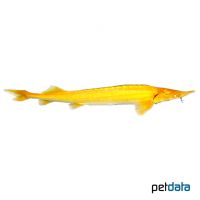Sterlet Sturgeon Albino (Acipenser ruthenus 'Albino')
| Sterlet Sturgeon Albino Acipenser ruthenus 'Albino' | |
|---|---|
| Name | Sterlet Sturgeon Albino |
| Name Lat. | Acipenser ruthenus 'Albino' |
| Family | Sturgeons |
| Family lat. | Acipenseridae |
| Order | Sturgeons & Paddlefishes |
| Order lat. | Acipenseriformes |
| Origin | Eurasia |
| Habitat | Rivers |
| Diet | Carnivore |
| pH | 6.5-8.0 |
| Behavior | Peaceful |
| Keeping | Individual, group |
| Care Level | Experts only |
| Reproduction | Oviparous |
| Breeding | None reported |
| Life Span | 20+ years |
| Protection | CITES Appendix II; EU Annex B |
| Metric Units | |
| Size | 40 cm |
| Temperature | 4-22 °C |
| Hardness | < 25 °dH |
| Aquarium | Pond |
| US Units | |
| Size | 16" |
| Temperature | 39-72 °F |
| Hardness | < 445 ppm |
| Aquarium | Pond |
Distribution and habitat
The albino sterlet is a color mutation. Sterlets are found in the tributaries of the Black and Caspian Seas, such as the Danube, Volga and Ural rivers, as well as in the Ob and Yenisei river systems, which flow into the northern Arctic Ocean. This smallest sturgeon species lives almost entirely in fresh water, where they prefer to live in the deep water of rivers with a clear current.
Maintenance
They require large ponds that are set up with a soft substrate suitable for burrowing, round river pebbles, and provide adequate swimming space. A light to moderate current is ideal
No ammonia, ammonium or nitrite should be detectable, and the nitrate value should not exceed 100 mg/l. To ensure the water quality and oxygen content, a filter adapted to the water volume should not be missing.
Diet
The agile fish have a large food requirement. In nature, they feed mainly on small fish and bottom-dwelling animals, such as crayfish and larvae. The food supply consists of a high-quality sinking dry food (granules, pellets) for sturgeons, supplemented with small crustaceans, fish spawn, insect larvae, fish and shellfish, which is also accepted without problems in frozen form, as well as earthworms, meal beetle larvae and snails.
Regular and varied feeding promotes health and increases resistance.
Behaviour and compatibility
They are peaceful fish that do not exhibit aggressive or incompatible behaviors and can be socialized well with other pond fish that are not too small.
In principle, only mutually compatible fish species with similar requirements for water quality and water temperature may be socialized.
Reproduction and breeding
There are no known external distinguishing characteristics.
They are largely sedentary and make only short spawning migrations. Males are sexually mature at 3-5 years, females at 5-8 years. They spawn on gravel bars in streams from April to June (free spawners) when water temperature rises above 10 °C. There are no known reports of successful breeding in the aquarium or pond.
Species protection
Species protection: WA Appendix II; EU Appendix B. The proof of purchase is the required proof of origin for the animal. Please keep it safe! Your pet store will be happy to provide you with further information.
Important
The water temperature should not exceed 20-22 °C. Sterlet are bred in fish farms, mostly in Eastern Europe, and are important fish in aquaculture. Free-living sterlet can reach a size of 80-100 cm, in human care they usually grow only 40 cm
At temperatures below 8 °C, the sterlet's metabolism slows and little food is accepted. If the temperature drops further, they bury themselves in burrows and hibernate. In the spring, as temperatures rise, feeding can slowly resume. Feeding may also be necessary during prolonged warm periods in winter
The well-being of the fish should be monitored regularly. A regular partial water change, according to the pond size is recommended, even if the pollutant load has not yet reached the upper limit. Sudden changes in water quality should be avoided. Newly introduced fish must be accustomed slowly to the water in the pond
Further literature can be found in your pet store.
References
Text: petdata; Image: petdata
Source: BMELV (1998): Tierschutzgutachten - Haltung von Zierfischen (Süßwasser); RIEHL & BAENSCH (2006): Aquarien Atlas Bd. 1, Mergus Verlag; ENGELMANN (2005): Zootierhaltung - Tiere in menschlicher Obhut: Fische; Harri Deutsch Verlag
- Gemäß § 21 Abs. 5 Tierschutzgesetz idgF
